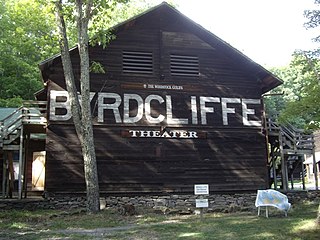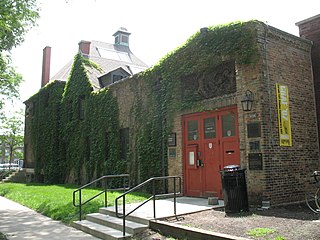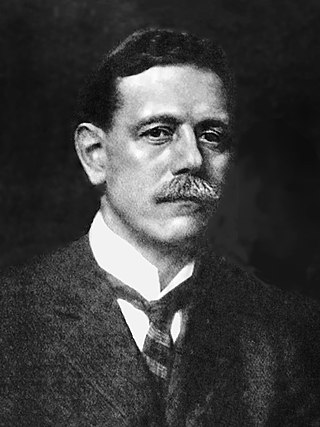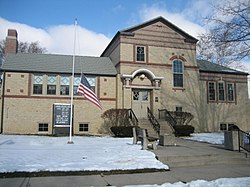
Oregon is a city in and the county seat of Ogle County, Illinois, United States. The population was 3,721 in 2010.

Lorado Zadok Taft was an American sculptor, writer and educator. Part of the American Renaissance movement, his monumental pieces include, Fountain of Time, Spirit of the Great Lakes, and The Eternal Indian. His 1903 book, The History of American Sculpture, was the first survey of the subject and stood for decades as the standard reference. He has been credited with helping to advance the status of women as sculptors.

The Eternal Indian, sometimes called the Black Hawk Statue, is a 48-foot sculpture by Lorado Taft located in Lowden State Park, near the city of Oregon, Illinois. Dedicated in 1911, the statue is perched over the Rock River on a 77-foot bluff overlooking the city.

Fountain of Time, or simply Time, is a sculpture by Lorado Taft, measuring 126 feet 10 inches (38.66 m) in length, situated at the western edge of the Midway Plaisance within Washington Park in Chicago, Illinois, in the United States. The sculpture is inspired by Henry Austin Dobson's poem "Paradox of Time". Its 100 figures passing before Father Time were created as a monument to the 100 years of peace between the United States and the United Kingdom following the Treaty of Ghent in 1814. Father Time faces the 100 from across a water basin. The fountain's water was turned on in 1920, and the sculpture was dedicated in 1922. It is a contributing structure to the Washington Park United States Registered Historic District, which is a National Register of Historic Places listing.

The Oregon Commercial Historic District is a historic district in Oregon, Illinois, that has been listed on the National Register of Historic Places since 2006. The district is roughly bordered by Jefferson, Franklin, 5th and 3rd Streets in Oregon. It is one of six Oregon sites listed on the National Register and one of three to be so listed since the turn of the 21st century. The other two are the Oregon Public Library, listed in 2003, and the Chana School, listed in 2005.

The Ogle County Courthouse is a National Register of Historic Places listing in the Ogle County, Illinois, county seat of Oregon. The building stands on a public square in the city's downtown commercial district. The current structure was completed in 1891 and was preceded by two other buildings, one of which was destroyed by a group of outlaws. Following the destruction of the courthouse, the county was without a judicial building for a period during the 1840s. The Ogle County Courthouse was designed by Chicago architect George O. Garnsey in the Romanesque Revival style of architecture. The ridged roof is dominated by its wooden cupola which stands out at a distance.

The Soldiers' Monument is a memorial consisting of three statues, one in bronze and two in marble by sculptor Lorado Taft, grouped around an exedra designed by the architectural firm of Pond and Pond. It is located in Oregon, Illinois, the county seat of Ogle County, Illinois. It was dedicated in 1916. The sculpture is part of the Oregon Commercial Historic District. The district was designated and listed on the National Register of Historic Places in August 2006.

The Byrdcliffe Colony, also called the Byrdcliffe Arts Colony or Byrdcliffe Historic District, was founded in 1902 near Woodstock, New York by Jane Byrd McCall and Ralph Radcliffe Whitehead and colleagues, Bolton Brown (artist) and Hervey White (writer). It is the oldest operating arts and crafts colony in America. The Arts and Crafts movement arose in the late nineteenth century in reaction to the dehumanizing monotony and standardization of industrial production. Byrdcliffe was created as an experiment in utopian living inspired by the Arts and Crafts movement.

The Eagle's Nest Art Colony, the site known in more modern times as the Lorado Taft Field Campus, was founded in 1898 by American sculptor Lorado Taft on the bluffs flanking the east bank of the Rock River, overlooking Oregon, Illinois. The colony was populated by Chicago artists, all members of the Chicago Art Institute or the University of Chicago art department, who gathered in Ogle County to escape the summer heat of Chicago. The colony complex has been used as a field campus for Northern Illinois University since 66 acres (27 ha) of Lowden State Park were turned over to the university by the state of Illinois.

Lowden State Park is an Illinois state park on 207 acres (84 ha) in Ogle County, Illinois, United States. The park was named after Governor Frank Orren Lowden. Governor Lowden had served Illinois during World War I. Lowden State Park is home to the Black Hawk Statue, by artist Lorado Taft. Lowden State Park was closed to the public due to budget cuts from November 30, 2008, until February 26, 2009.

The Lorado Taft Midway Studios are a historic artist studio complex at South Ingleside Avenue and East 60th Street, on the campus of the University of Chicago on the South Side of Chicago. The architecturally haphazard structure, originating as two converted barns and a Victorian house, was used from 1906 to 1929 as the studio of Lorado Taft (1860-1936), one of the most influential sculptors of the period. A National Historic Landmark, it now houses the university's visual arts department.

The Aitkin Carnegie Library is a Carnegie library in Aitkin, Minnesota, United States. It was designed by architects Claude & Starck and was built in the Classical Revival style. It was listed on the National Register of Historic Places in 1982.
The Museum of Contemporary Craft based in Portland, Oregon was the oldest continuously-running craft institution on the west coast of the United States until its closing in 2016. At the time of its closure, it was located in downtown Portland's Pearl District, the museum's mission was "to enliven and expand the understanding of craft and the museum experience."

The Pendleton Center for the Arts is an arts center located in the historic former Umatilla County Library building, also known as Pendleton Public Library in Pendleton, Oregon, United States.

Irving Kane Pond was an American architect, college athlete, and author. Born in Ann Arbor, Michigan, Pond attended the University of Michigan and received a degree in civil engineering in 1879. He was a member of the first University of Michigan football team and scored the first touchdown in the school's history in May 1879.
Pond and Pond was an American architecture firm established by the Chicago architects Irving Kane Pond and Allen Bartlitt Pond.

Peter Bonnett Wight was an American 19th-century architect from New York City who worked there and in Chicago.

The Rockland Public Library is located at 80 Union Street in central Rockland, Maine. It is located in an architecturally distinguished building, built in 1903–04 with funding support from Andrew Carnegie. The library was listed on the National Register of Historic Places in 1979 for its architecture. The library is one of the only libraries in Maine designated as a "Star Library" by Library Journal.

The Main Library is a historic library on the campus of the University of Illinois Urbana-Champaign in Urbana, Illinois. Built in 1924, the library was the third built for the school; it replaced Altgeld Hall, which had become too small for the university's collections. Architect Charles A. Platt designed the Georgian Revival building, one of several on the campus which he designed in the style. The building houses several area libraries, as well as the University Archives and the Rare Book & Manuscript Library. The Main Library is the symbolic face of the University Library, which has the second largest university library collection in the United States.
William A. Harper was a Canadian-born artist best known for his landscape paintings, and is represented in both the Metropolitan Museum of Art in New York City and the National Museum of African American History in Washington, D.C. Harper was born in the village of Canfield, near Cayuga, Ontario, Canada, and immigrated to Illinois in 1885. He graduated from the Art Institute of Chicago (“AIC”) in 1901, and subsequently studied at the Académie Julian in Paris, France. Harper's paintings were regularly accepted in juried exhibitions of the AIC and the Society of Western Artists and were acknowledged with multiple awards.






















